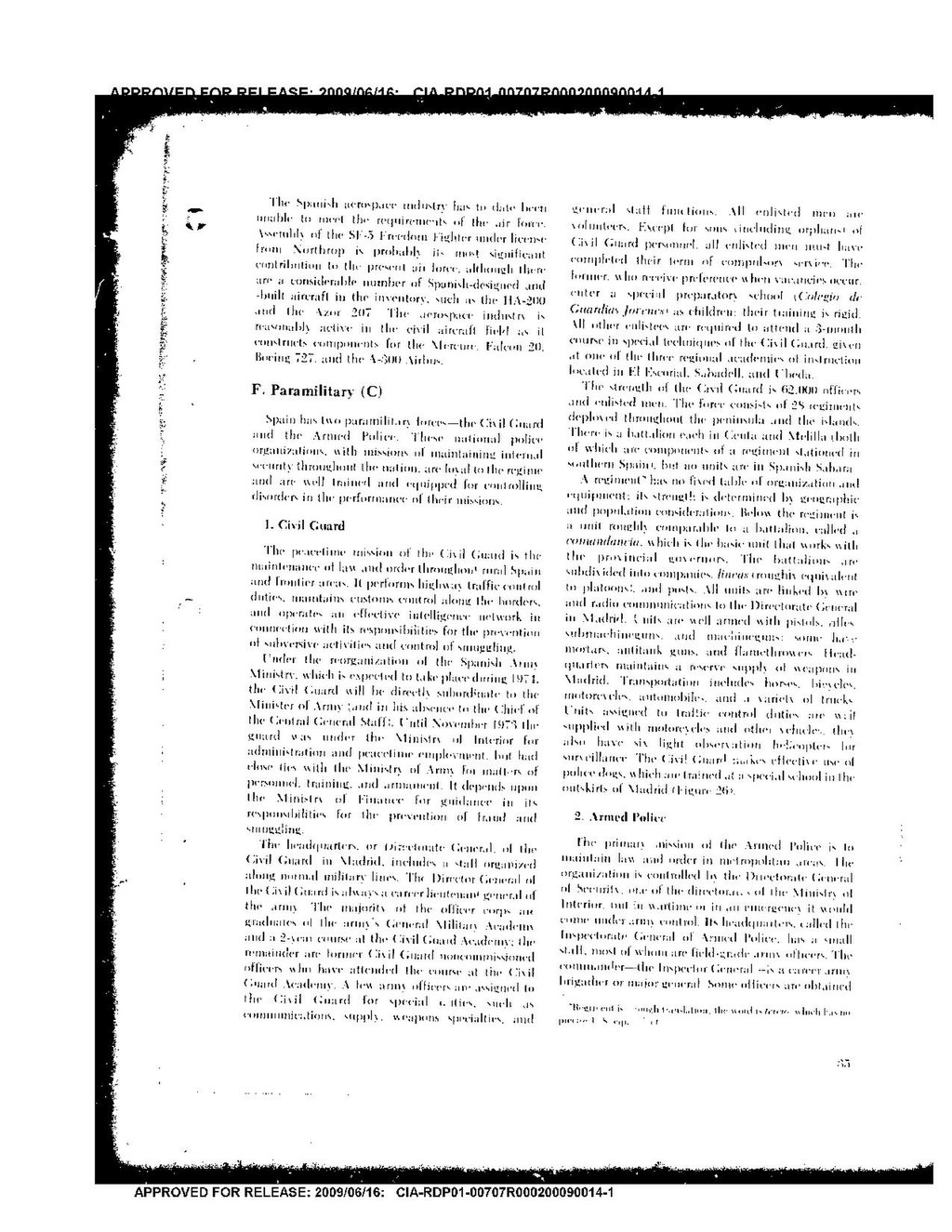APPROVED FOR RELEASE: 2009/06/16: CIA-RDP01-00707R000200090014-1
The Spanish aerospace industry has to date been unable to meet the requirements of the air force. Assembly of the SF-5 Freedom Fighter under license from Northrop is probably its most significant contribution to the present air force, although there are a considerable number of Spanish-designed and built aircraft in the inventory, such as the HA-200 and the Azor 207. The aerospace industry is reasonably active in the civil aircraft field as it constructs components for the Mercure, Falcon 20, Boeing 727, and the A-300 Airbus.
F. Paramilitary (C)
Spain has two paramilitary forces -- the Civil Guard and the Armed Police. These national police organizations, with missions of maintaining internal security throughout the nation, are loyal to the regime and are well trained and equipped for controlling disorders in the performance of their missions.
1. Civil Guard
The peacetime mission of the Civil Guard is the maintenance of law and order throughout rural Spain and frontier areas. It performs highway traffic control duties, maintains customs control along the borders, and operates an effective intelligence network in connection with its responsibilities for the prevention of subversive activities and control of smuggling.
Under the reorganization of the Spanish Army Ministry, which is expected to take place during 1974, the Civil Guard will be directly subordinate to the Minister of Army (and in his absence to the Chief of the Central General Staff). Until November 1973 the guard was under the Ministry of Interior for administration and peacetime employment, but had close ties with the Ministry of Army for matters of personnel, training, and armament. It depends upon the Ministry of Finance for guidance in its responsibilities for the prevention of fraud and smuggling.
The headquarters, or Directorate General, of the Civil Guard in Madrid, includes a staff organized along normal military lines. The Director General of the Civil Guard is always a career lieutenant general of the army. The majority of the officer corps are graduates of the army's General Military Academy and a 2-year course at the Civil Guard Academy; the remainder are former Civil Guard noncommissioned officers who have attended the course at the Civil Guard Academy. A few army officers are assigned to the Civil Guard for special duties, such as communications, supply, weapons specialties, and general staff functions. All enlisted men are volunteers. Except for sons (including orphans) of Civil Guard personnel, all enlisted men must have completed their term of compulsory service. The former, who receive preference when vacancies occur, enter a special preparatory school (Colegio de Guardias Jovenes) as children; their training is rigid. All other enlistees are required to attend a 3-month course in special techniques of the Civil Guard, given at one of the three regional academies of instruction located in El Escorial, Sabadell, and Ubeda.
The strength of the Civil Guard is 62,000 officers and enlisted men. The force consists of 28 regiments deployed throughout the peninsula and the islands. There is a battalion each in Ceuta and Melilla (both of which are components of a regiment stationed in southern Spain), but no units are in Spanish Sahara.
A regiment has no fixed table of organization and equipment; its strength is determined by geographic and population considerations. Below the regiment is a unit roughly comparable to a battalion, called a comandancia, which is the basic unit that works with the provincial governors. The battalions are subdivided into companies, lineas (roughly equivalent to platoons), and posts. All units are linked by wire and radio communications to the Directorate General in Madrid. Units are well armed with pistols, rifles, submachine guns, and machine guns; some have mortars, anti-tank guns, and flamethrowers. Headquarters maintains a reserve supply of weapons in Madrid. Transportation includes horses, bicycles, motorcycles, automobiles, and a variety of trucks. Units assigned to traffic control duties are well supplied with motorcycles and other vehicles, they also have six light observation helicopters for surveillance. The Civil Guard makes effective use of police dogs, which are trained at a special school in the outskirts of Madrid.
2. Armed Police
The primary mission of the Armed Police is to maintain law and order in metropolitan areas. The organization is controlled by the Directorate General of Security, one of the directorates of the Ministry of Interior, but in wartime or in an emergency it would come under army control. Its headquarters, called the Inspectorate General of Armed Police, has a small staff, most of whom are field-grade army officers. The commander -- the Inspector General -- is a career arms brigadier or major general. Some officers are obtained
35
APPROVED FOR RELEASE: 2009/06/16: CIA-RDP01-00707R000200090014-1

